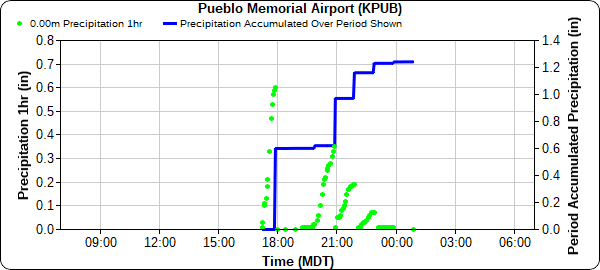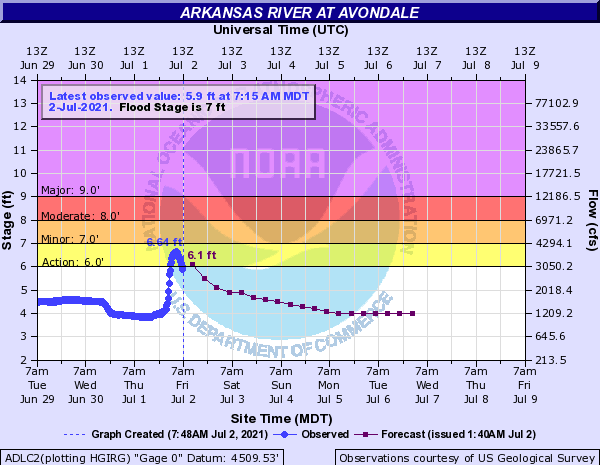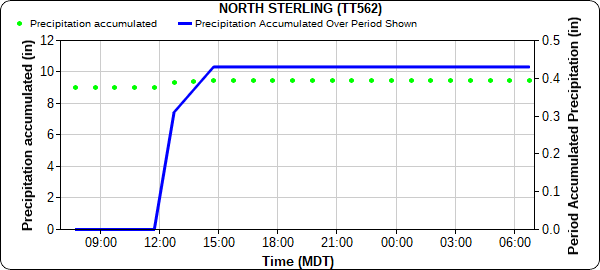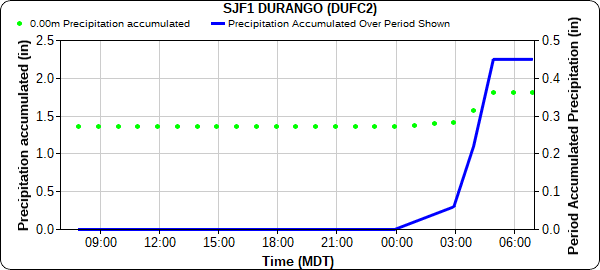Issue Date: Friday, July 2, 2021
Issue Time: 10:45 AM MDT
Summary:
Yesterday kicked off with an early morning storm in the Grand Valley – a trained spotter reported a quick 0.24 inches of heavy rain in Grand Junction before dissipating around 8:00 am. There was also an early morning line of storms associated with a low-pressure system in the Southeast Plains, which moved eastward into Kansas through the morning. In the late morning and early afternoon things really started to kick off in the Northern and Front Range Mountains, Urban Corridor, Southeast Mountains, and Southeast Plains. By 11:00 am, lines of thunderstorms, some severe, were building and producing heavy rainfall. Fueled by additional monsoonal moisture, storms strengthened throughout the day until they finally dissipated from north to south overnight.
The big “winner” of the day in terms of total storm precipitation was Greeley, which recorded between 2-3+ inches across town in just a few hours. A CoCoRaHS observer in West Greeley reported a total of 3.40 inches, and a nearby Weather Underground PWS recorded 3.43 inches in just under 3-hours. To put that into perspective, 3.43 inches in 3-hours relates to a 90-year rainfall event, or only a 1.1% chance of occurring in any given year!
Flash flood warnings were issued for the heavy rain, and several reports were made across Greeley of significant road flooding. The following tweet from Marc Sallinger shows some of the flooding and damage reported.
Greeley has some pretty major flooding right in the middle of town after a storm dropped 3-4in of rain in an hour. Streets are closed, sand bags are being put up, and people are trying to get the water out of buildings #9News pic.twitter.com/WLq3fzZHN4
— Marc Sallinger (@MarcSallinger) July 1, 2021
While the Cache la Poudre River near Greeley did not make it to action or flood stage, the river’s response to the heavy rain can be seen in the hydrograph below, showing the rapid increase in river stage, which peaked at 5.53 feet last night.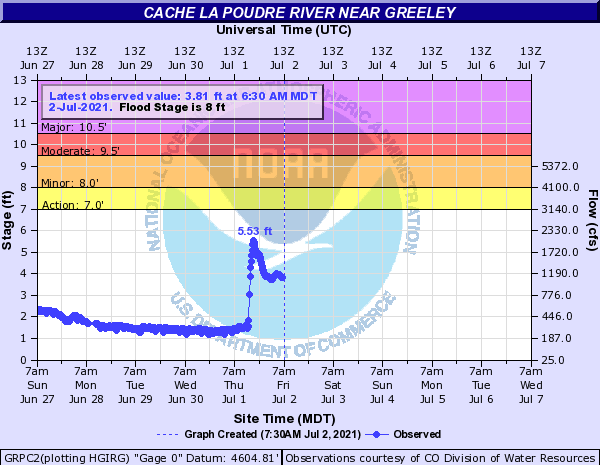
Heavy rainfall and flooding was also reported in Pueblo, which recorded a new record high rainfall for the day. At around 9:30 pm, the NWS Pueblo office tweeted that the Pueblo Memorial Airport had received 1.10 inches for the day, breaking the previous record. Ultimately, the airport received 1.24 inches in in about 4-hours, as seen in the time series plot below.
As of this moment, the METAR station at the Pueblo Memorial Airport has recorded ~1.10in of rain so far today and this breaks the old daily record of 0.67in! This value is expected to go up more as rain continues over the area. #cowx
— NWS Pueblo (@NWSPueblo) July 2, 2021
Though it broke the daily rainfall record, 1.24 inches was not particularly rare of an event. Precipitation Frequency Estimates from NOAA 14 at Pueblo have the 2-year, 6-hour rainfall event at 1.31 inches. Still, street flooding was reported and resulted in road closures. Nearby, the Arkansas River at Avondale reached action stage overnight, peaking at 6.64 feet, just below the minor flood stage of 7.0 feet.
Another cell dropped heavy rainfall between Boulder and the West Denver Suburbs, causing flash flooding. A MHFD gauge in Westminster recorded 2.05 inches in 24-hours, but a majority of that fell in just 2-hours, with a single hourly observation of 1.85 inches/hour. 1-hour precipitation frequency estimates in this area put this just above a 25-year event. A CoCoRaHS observer in east Boulder also reported 2.05 inches and they left the following remark emphasizing the heavy rainfall and wet year so far on their daily report:
Crazy heavy thunderstorm with 1.91″ of rain between near the start ~1600 to 1645. A little tiny hail at times midway through the event. Did not notice any substantial flooding but lots of dramatic runoff. Thunder and R- lingered until about 1700 (another 0.04), then another thunderstorm more to our south dropped 0.10″ ~1800-1830. Now have over 18″ since 1 Jan, more than my 17 year average of ~17.50 and blowing by last year’s 14.36″. A MHFD gauge over the Calwood fire burn area recorded 0.75 inches over a 4-hour period.
Further west, Buena Vista and Salida saw heavy rain and flooding. Up to 2.46 inches was recorded in Salida by CoCoRaHS observers, who also remarked that they have “Never witnessed this much rain come down in the 45 years we’ve lived at this location! Began about 8:00pm and poured for about an hour with lightning, thunder and wind”. 2.46 inches in 2-hours relates to an approximately 145-year rainfall event, or 0.7% chance of occurrence! Country Roads 28, 110, 111, 304 were reported as flooded and washed out in Chaffee County.
The list of areas receiving heavy rainfall is extensive across the eastern portion of the state. East of Denver, 3.71 inches was reported in rural Arapahoe County from a storm that also warranted severe thunderstorm and flash flood warnings. All the way down to the Colorado-New Mexico border, Trinidad received up to 1.80 inches, also reported by CoCoRaHS observers.
Almost miraculously, there was no flooding reported on the many fire burn scars. Thunderstorms over the Muddy Slide fire were described as a “mixed blessing” – while rainfall helps to slow the spread, it is not usually enough to extinguish fires completely and increases the risk of lightning and high winds. Conditions were similar for the Sylvan fire, which has also received light rain over several days.
What a day! For rainfall estimates in your area, check out the State Precipitation Map below
Click Here For Map Overview

